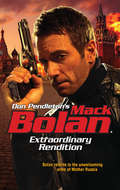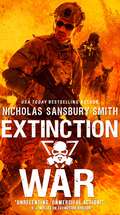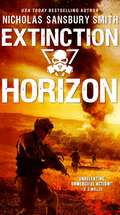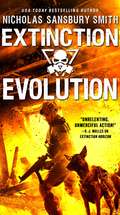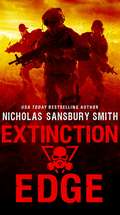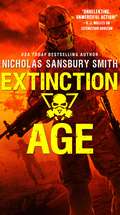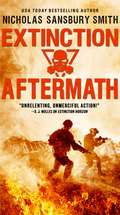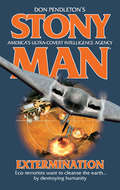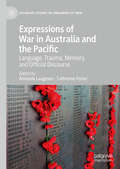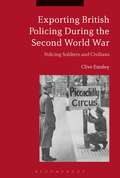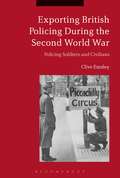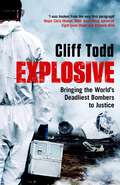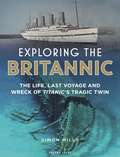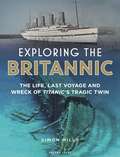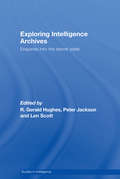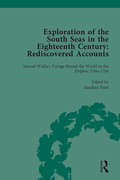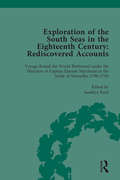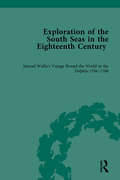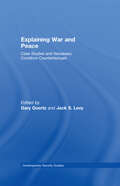- Table View
- List View
Extraordinary Rendition
by Don PendletonOn the streets of a democratic Russia, espionage, civil war and Mafiya control dominate a new kind of battlefield. Bolan's mission: locate, extract and deliver a ruthless Russian arms dealer to a transport team ready to take him back to the United States to stand trial.
The Extraordinary Life of Alan Turing (Extraordinary Lives)
by Michael Lee RichardsonThe man whose maths saved millions of lives.Alan Turing was a mathematician, scientist and codebreaker who helped defeat the Nazis in the Second World War with his incredible decoding of secret messages from enemy soldiers.Discover his life story in this beautifully illustrated book, from his childhood as a quiet boy who loved maths, to becoming one of the most important scientists and codebreakers in history.Collect them all!Packed full of incredible stories, fantastic facts and dynamic illustrations, Extraordinary Lives shines a light on important modern and historical figures from all over the world. OUT NOW:The Extraordinary Life of Stephen Hawking The Extraordinary Life of Neil Armstrong The Extraordinary Life of Katherine JohnsonCOMING THIS YEAR: The Extraordinary Life of Greta Thunberg The Extraordinary Life of Amelia Earhart
Extinction War (The Extinction Cycle #7)
by Nicholas Sansbury SmithThe seventh and never-before-published book in USA Today bestselling Nicholas Sansbury Smith's propulsive post-apocalyptic series about one man's mission to save the world. An army advances...In Europe, Master Sergeant Joe Fitzpatrick and Team Ghost return from a mission deep into enemy territory only to find that the Variant army has grown stronger, and they are advancing toward the EUF's stronghold in Paris. On the brink of Civil War...Back in the United States, President Ringgold and Dr. Kate Lovato are on the run. The Safe Zone Territories continue to rally behind the ROT flag, leaving Ringgold more enemies than allies. But there are still those who will stand and fight for America. Captain Rachel Davis and Captain Reed Beckham will risk everything to defeat ROT and save the country from collapsing into Civil War. Humanity may be its own worst enemy... pick up the series that D. J. Molles said "delivers unrelenting, unmerciful action" before it's too late!The Extinction Cycle:Book 1: Extinction HorizonBook 2: Extinction EdgeBook 3: Extinction AgeBook 4: Extinction EvolutionBook 5: Extinction EndBook 6: Extinction AftermathBook 7: Extinction War
Extinction Horizon (The Extinction Cycle #1)
by Nicholas Sansbury SmithUSA Today bestseller Nicholas Sansbury Smith's first book in his thrilling post-apocalyptic series about one man's mission to save the world. Master Sergeant Reed Beckham has led his Delta Force Team, codenamed Ghost, through every kind of hell imaginable and never lost a man. When a top secret Medical Corps research facility goes dark, Team Ghost is called in to face their deadliest enemy yet--a variant strain of Ebola that turns men into monsters. After barely escaping with his life, Beckham returns to Fort Bragg in the midst of a new type of war. As cities fall, Team Ghost is ordered to keep CDC virologist Dr. Kate Lovato alive long enough to find a cure. What she uncovers will change everything. Total extinction is just on the horizon, but will the cure be worse than the virus?Extinction is just on the horizon... Start reading the book that D. J. Molles said "delivers unrelenting unmerciful action" before it's too late!The Extinction Cycle:Book 1: Extinction HorizonBook 2: Extinction EdgeBook 3: Extinction AgeBook 4: Extinction EvolutionBook 5: Extinction EndBook 6: Extinction AftermathBook 7: Extinction War
Extinction Horizon (The Extinction Cycle #1)
by Nicholas Sansbury SmithUSA Today bestseller Nicholas Sansbury Smith's first book in his thrilling post-apocalyptic series about one man's mission to save the world. Master Sergeant Reed Beckham has led his Delta Force Team, codenamed Ghost, through every kind of hell imaginable and never lost a man. When a top secret Medical Corps research facility goes dark, Team Ghost is called in to face their deadliest enemy yet -- a variant strain of Ebola that turns men into monsters.After barely escaping with his life, Beckham returns to Fort Bragg in the midst of a new type of war. As cities fall, Team Ghost is ordered to keep CDC virologist Dr. Kate Lovato alive long enough to find a cure. What she uncovers will change everything. Total extinction is just on the horizon, but will the cure be worse than the virus?Extinction is just on the horizon. . . Start reading the book that D. J. Molles said "delivers unrelenting unmerciful action" before it's too late!
Extinction Evolution (The Extinction Cycle #4)
by Nicholas Sansbury SmithThe fourth book in USA Today bestselling author Nicholas Sansbury Smith's propulsive post-apocalyptic series about one man's mission to save the world.Central Command is gone, the military is fractured, and the surviving members of Team Ghost, led by Master Sergeant Reed Beckham, have been pushed to the breaking point. Betrayed by the country they swore to defend and surrounded by enemies on all sides, Team Ghost has one mission left: protect Dr. Kate Lovato and Dr. Pat Ellis while they develop a weapon to defeat the Variants once and for all. But after a grisly discovery in Atlanta, Kate and Ellis realize their weapon might not be able to stop the evolution of the monsters.Joined by unexpected allies and facing a new threat none of them saw coming, the survivors are running out of time to save the human race from extinction.There's a storm on the horizon... pick up the series that D. J. Molles said "delivers unrelenting, unmerciful action" before it's too late! The Extinction Cycle:Book 1: Extinction HorizonBook 2: Extinction EdgeBook 3: Extinction AgeBook 4: Extinction EvolutionBook 5: Extinction EndBook 6: Extinction AftermathBook 7: Extinction War
Extinction End (The Extinction Cycle #5)
by Nicholas Sansbury SmithThe fifth book in USA Today bestselling author Nicholas Sansbury Smith's propulsive post-apocalyptic series about one man's mission to save the world.Almost seven weeks have passed since the Hemorrhage Virus ravaged the world. The remnants of the United States military have regrouped and relocated Central Command to the George Washington Carrier Strike Group. It's here, in the North Atlantic, that President Jan Ringgold and Vice President George Johnson prepare to deploy a new bioweapon and embark on the final mission to take back the country from the Variants.With his home gone and his friends kidnapped, Master Sergeant Reed Beckham and his remaining men must take drastic measures to save what's left of the human race.The end is here... pick up the series that D. J. Molles said "delivers unrelenting, unmerciful action" before it's too late!The Extinction Cycle:Book 1: Extinction HorizonBook 2: Extinction EdgeBook 3: Extinction AgeBook 4: Extinction EvolutionBook 5: Extinction EndBook 6: Extinction AftermathBook 7: Extinction War
Extinction Edge (The Extinction Cycle #2)
by Nicholas Sansbury SmithThe second book in USA Today bestselling author Nicholas Sansbury Smith's propulsive post-apocalyptic series about one man's mission to save the world. The dust from Dr. Kate Lovato's bioweapon has settled. Projections put death counts in the billions. Her weapon was supposed to be the endgame, but it turned a small percentage of those infected with the Hemorrhage Virus into something even worse. Survivors call them Variants. Irreversible epigenetic changes have transformed them into predators unlike any the human race has ever seen. And they are evolving. The fractured military plans Operation Liberty--a desperate mission designed to take back the cities and destroy the Variant threat. Master Sergeant Reed Beckham agrees to lead a strike team into New York City, but first he must return to Fort Bragg to search for the only family he has left. As Operation Liberty draws closer, Kate warns Beckham that Team Ghost won't just face their deadliest adversary yet, they may be heading into a trap...Humanity is on the edge of extinction... pick up the series that D. J. Molles said "delivers unrelenting, unmerciful action"before it's too late!The Extinction Cycle:Book 1: Extinction HorizonBook 2: Extinction EdgeBook 3: Extinction AgeBook 4: Extinction EvolutionBook 5: Extinction EndBook 6: Extinction AftermathBook 7: Extinction War
Extinction Age (The Extinction Cycle #3)
by Nicholas Sansbury SmithThe third book in USA Today bestselling author Nicholas Sansbury Smith's propulsive post-apocalyptic series about one man's mission to save the world.Humans are losing the war. Master Sergeant Reed Beckham and the survivors of 1st Platoon must battle through the tunnels--where they make a grisly discovery. Dr. Kate Lovato is working on a new bioweapon to destroy the Variants when a derelict Navy Destroyer crashes into the Connecticut shoreline carrying yet another threat. As the doomsday clock ticks down and military bases fall across the country, the human race enters the age of extinction. Will they prevail--or will mankind vanish off the face of the planet?In the fight for humanity, one final hope remains... pick up the series that D. J. Molles said "delivers unrelenting, unmerciful action" before it's too late!The Extinction Cycle:Book 1: Extinction HorizonBook 2: Extinction EdgeBook 3: Extinction AgeBook 4: Extinction EvolutionBook 5: Extinction EndBook 6: Extinction AftermathBook 7: Extinction War
Extinction Aftermath (The Extinction Cycle #6)
by Nicholas Sansbury SmithThe sixth book in USA Today bestselling author Nicholas Sansbury Smith's propulsive post-apocalyptic series about one man's mission to save the world.The newly christened leader of Delta Force Team Ghost, Master Sergeant Joe Fitzpatrick arrives in Normandy over 70 years after Allied Forces joined the fight against the Nazis. The war to free survivors and eradicate pockets of adult Variants and their offspring is underway by the European Unified Forces. But as the troops push east, rumors of a new type of monster spread through the ranks. Fitz and his new team quickly realize that the fight for Europe might be harder than anyone ever imagined.Back in the States, Captain Reed Beckham and Dr. Kate Lovato are settling into a new life on Plum Island. Across the United States, the adult Variants have all been wiped out, and the juveniles are on the run. But the survivors soon realize there are other monsters at home, and they may be human.A new monster emerges... pick up the series that D. J. Molles said "delivers unrelenting, unmerciful action" before it's too late!The Extinction Cycle:Book 1: Extinction HorizonBook 2: Extinction EdgeBook 3: Extinction AgeBook 4: Extinction EvolutionBook 5: Extinction EndBook 6: Extinction AftermathBook 7: Extinction War
Extermination
by Don PendletonWhen Stony Man is called to battle, the crisis is real and immediate. Cybernetics experts run logistics from the war room of a secret facility known only to the President.
Expressions of War in Australia and the Pacific: Language, Trauma, Memory, and Official Discourse (Palgrave Studies in Languages at War)
by Amanda Laugesen Catherine FisherThis edited book includes chapters that explore the impact of war and its aftermath in language and official discourse. It covers a broad chronological range from the First World War to very recent experiences of war, with a focus on Australia and the Pacific region. It examines three main themes in relation to language: the impact of war and trauma on language, the language of war remembrance, and the language of official communications of war and the military. An innovative work that takes an interdisciplinary approach to the themes of war and language, the collection will be of interest to students and scholars across linguistics, literary studies, history and conflict studies.
Exporting British Policing During the Second World War: Policing Soldiers and Civilians
by Clive EmsleyExporting British Policing is a comprehensive study of British military policing in liberated Europe during the Second World War. Preventing and detecting thefts, receiving and profiteering together with the maintenance of order in its broadest sense are, in the peacetime world, generally confided to the police. However, the Second World War witnessed the use of civilian police to create a detective division of the British Army's Military Police (SIB), and the use of British civilian police, alongside American police, as Civil Affairs Officers to restore order and civil administration. Part One follows the men of the SIB from their pre-war careers to confrontations with mafiosi and their investigations into widespread organised crime and war crimes during which they were constantly hampered by being seen as a Cinderella service commanded by 'temporary gentlemen'. Part Two focuses on the police officers who served in Civil Affairs who tended to come from higher ranks in the civilian police than those who served in SIB. During the war they occupied towns with the assault troops, and then sought to reorganise local administration; at the end of the war in the British Zones of Germany and Austria they sought to turn both new Schutzmänner and police veterans of the Third Reich into British Bobbies. Using memoirs and anecdotes, Emsley critically draws on the subjective experiences of these police personnel, assessing the successes of these wartime efforts for preventing and investigating crimes such as theft and profiteering and highlighting the importance of historical precedent, given current difficulties faced by international policing organizations in enforcing democratic police reform in post-conflict societies.
Exporting British Policing During the Second World War: Policing Soldiers and Civilians
by Clive EmsleyExporting British Policing is a comprehensive study of British military policing in liberated Europe during the Second World War. Preventing and detecting thefts, receiving and profiteering together with the maintenance of order in its broadest sense are, in the peacetime world, generally confided to the police. However, the Second World War witnessed the use of civilian police to create a detective division of the British Army's Military Police (SIB), and the use of British civilian police, alongside American police, as Civil Affairs Officers to restore order and civil administration. Part One follows the men of the SIB from their pre-war careers to confrontations with mafiosi and their investigations into widespread organised crime and war crimes during which they were constantly hampered by being seen as a Cinderella service commanded by 'temporary gentlemen'. Part Two focuses on the police officers who served in Civil Affairs who tended to come from higher ranks in the civilian police than those who served in SIB. During the war they occupied towns with the assault troops, and then sought to reorganise local administration; at the end of the war in the British Zones of Germany and Austria they sought to turn both new Schutzmänner and police veterans of the Third Reich into British Bobbies. Using memoirs and anecdotes, Emsley critically draws on the subjective experiences of these police personnel, assessing the successes of these wartime efforts for preventing and investigating crimes such as theft and profiteering and highlighting the importance of historical precedent, given current difficulties faced by international policing organizations in enforcing democratic police reform in post-conflict societies.
Explosive: Bringing the World's Deadliest Bombers to Justice
by Cliff ToddTHE STORY OF BRITAIN'S LEADING FORENSIC EXPLOSIVES SCIENTIST, WHO FOR NEARLY THREE-DECADES INVESTIGATED SOME OF THE MOST PROMINENT NATIONAL AND INTERNATIONAL CRIMINAL BOMB ATTACKS IN HISTORY.Cliff Todd devoted his life to bringing bomb makers to justice. He and his colleagues at the Ministry of Defence's Forensic Explosives Laboratory are the unsung heroes of terrorist bomb attacks - the men and women in white suits who piece together who planted the bombs, what a device consisted of and how the perpetrators might give themselves away.They played a pivotal role in uncovering the secrets behind some of the world's most horrifying terrorist outrages. Explosive tells the stories of these high-profile cases and details, for the first time, the contribution Todd and his team made in tracking down bombers during a time when Britain was under attack first by the IRA and then by Islamic extremists inspired by al-Qaeda.Explosive takes the reader into the murky world of the amateur bomb maker, and reveals what Todd's department achieved in many now infamous attacks, including the device concealed in a radio cassette player that brought down Pan Am Flight 103 over Lockerbie, the IRA attacks on Warrington in Cheshire, the Bali nightclub bombings of 2002, and the 7/7 onslaught in central London that claimed 56 lives and injured 784 others in 2005.In Explosive, Todd takes us step by step through the investigations, explaining the chemistry, the forensic work and the emotional toll on him and his staff as they sought to recreate and understand what had happened at some of the most shocking tragedies in modern peacetime history.
Exploring the Britannic: The life, last voyage and wreck of Titanic's tragic twin
by Simon MillsLaunched in 1914, two years after the ill-fated voyage of her sister ship, RMS Titanic, the Britannic was intended to be superior to her tragic twin in every way. But war intervened and in 1915 she was requisitioned as a hospital ship. Just one year later, while on her way to collect troops wounded in the Balkans campaign, she fell victim to a mine laid by a German U-boat and tragically sank in the middle of the Aegean Sea.There her wreck lay, at a depth of 400 feet, until it was discovered 59 years later by legendary explorer Jacques Cousteau. In 1996 the wreck was bought by the author of this book, Simon Mills.Exploring the Britannic tells the complete story of this enigmatic ship: her construction, launch and life, her fateful last voyage, and the historical findings resulting from the exploration of the well-preserved wreck over a period of 40 years. With remarkable sonar scans and many never before seen photographs of the wreck, plus the original Harland & Wolff ship plans, not previously published in their entirety, Exploring the Britannic finally details how the mysteries surrounding the 100-year-old enigma were laid to rest, and what the future might also hold for her.
Exploring the Britannic: The life, last voyage and wreck of Titanic's tragic twin
by Simon MillsLaunched in 1914, two years after the ill-fated voyage of her sister ship, RMS Titanic, the Britannic was intended to be superior to her tragic twin in every way. But war intervened and in 1915 she was requisitioned as a hospital ship. Just one year later, while on her way to collect troops wounded in the Balkans campaign, she fell victim to a mine laid by a German U-boat and tragically sank in the middle of the Aegean Sea.There her wreck lay, at a depth of 400 feet, until it was discovered 59 years later by legendary explorer Jacques Cousteau. In 1996 the wreck was bought by the author of this book, Simon Mills.Exploring the Britannic tells the complete story of this enigmatic ship: her construction, launch and life, her fateful last voyage, and the historical findings resulting from the exploration of the well-preserved wreck over a period of 40 years. With remarkable sonar scans and many never before seen photographs of the wreck, plus the original Harland & Wolff ship plans, not previously published in their entirety, Exploring the Britannic finally details how the mysteries surrounding the 100-year-old enigma were laid to rest, and what the future might also hold for her.
Exploring Intelligence Archives: Enquiries into the Secret State (Studies in Intelligence)
by R. Gerald Hughes Peter Jackson Len ScottThis edited volume brings together many of the world’s leading scholars of intelligence with a number of former senior practitioners to facilitate a wide-ranging dialogue on the central challenges confronting students of intelligence. The book presents a series of documents, nearly all of which are published here for the first time, accompanied by both overview and commentary sections. The central objectives of this collection are twofold. First, it seeks to build on existing scholarship on intelligence in deepening our understanding of its impact on a series of key events in the international history of the past century. Further, it aims to explore the different ways in which intelligence can be studied by bringing together both scholarly and practical expertise to examine a range of primary material relevant to the history of intelligence since the early twentieth century. This book will be of great interest to students of intelligence, strategic and security studies, foreign policy and international history.
Exploring Intelligence Archives: Enquiries into the Secret State (Studies in Intelligence)
by R. Gerald Hughes Peter Jackson Len ScottThis edited volume brings together many of the world’s leading scholars of intelligence with a number of former senior practitioners to facilitate a wide-ranging dialogue on the central challenges confronting students of intelligence. The book presents a series of documents, nearly all of which are published here for the first time, accompanied by both overview and commentary sections. The central objectives of this collection are twofold. First, it seeks to build on existing scholarship on intelligence in deepening our understanding of its impact on a series of key events in the international history of the past century. Further, it aims to explore the different ways in which intelligence can be studied by bringing together both scholarly and practical expertise to examine a range of primary material relevant to the history of intelligence since the early twentieth century. This book will be of great interest to students of intelligence, strategic and security studies, foreign policy and international history.
Exploration of the South Seas in the Eighteenth Century: Samuel Wallis’s Voyage Round the World in the Dolphin 1766-1768 (Routledge Historical Resources)
by Sandhya PatelThe publication of key voyaging manuscripts has contributed to the flourishing of enduring and prolific worldwide scholarship across numerous fields. These navigators and their texts were instrumental in spurring on further exploration, annexation and ultimately colonisation of the pacific territories in the space of only a few decades. This series will present new sources and primary texts in English, paving the way for postcolonial critical approaches in which the reporting, writing, rewriting and translating of Empire and the ‘Other’ takes precedence over the safeguarding of master narratives. Each of the volumes contains an introduction that sets out the context in which these voyages took place and extensive annotations clarify and explain the original texts. The first volume makes available Samuel Wallis’ logs of the Dolphin’s voyage 1766-68 in their original form for the first time. Captain Samuel Wallis was the first Englishman to come across the Tuamotus and the Society Isles in the South Pacific, specifically Tahiti. His writings predate the available textual sources by Louis-Antoine de Bougainville, the logs of the Spanish voyages and James Cook — whose text Wallis’ prefigures. The three logs attest to the very first encounter between Europeans and Tahitians, but until now comparatively little research has been conducted on the more elaborate second volume and none on the first. The Polynesian archipelagos grew into objects of discourse over the years and Wallis' logs may very well be located at the heart of these evocative constructs.
Exploration of the South Seas in the Eighteenth Century: Voyage Round the World Performed under the Direction of Captain Etienne Marchand in the Solide of Marseilles 1790-1792 (Routledge Historical Resources)
by Sandhya PatelThe publication of key voyaging manuscripts has contributed to the flourishing of enduring and prolific worldwide scholarship across numerous fields. These navigators and their texts were instrumental in spurring on further exploration, annexation and ultimately colonisation of the pacific territories in the space of only a few decades. This series will present new sources and primary texts in English, paving the way for postcolonial critical approaches in which the reporting, writing, rewriting and translating of Empire and the ‘Other’ takes precedence over the safeguarding of master narratives. Each of the volumes contains an introduction that sets out the context in which these voyages took place and extensive annotations clarify and explain the original texts. The translated accounts of voyages undertaken by foreign vessels abounded in an era when they encouraged not only competitive geopolitical initiatives but also commercial enterprises throughout Europe, resulting in a voluminous textual corpus. However, French merchant-seaman Etienne Marchand’s journal of his voyage round the world in 1790-1792, encompassing an important visit to the Marquesas Archipelago during his first crossing of the Pacific, remained unpublished until 2005 and has only now been made available in English. The second volume of this series comprises an annotated translation in English of this document.
Exploration of the South Seas in the Eighteenth Century: Rediscovered Accounts
by Sandhya PatelThe publication of key voyaging manuscripts has contributed to the flourishing of enduring and prolific worldwide scholarship across numerous fields. These navigators and their texts were instrumental in spurring on further exploration, annexation and ultimately colonisation of the Pacific territories in the space of only a few decades. This series will present new sources and primary texts in English, paving the way for postcolonial critical approaches in which the reporting, writing, rewriting and translating of Empire and the ‘Other’ takes precedence over the safeguarding of master narratives. Each of the volumes contains an introduction that sets out the context in which these voyages took place and extensive annotations clarify and explain the original texts. The first volume makes available Samuel Wallis’ logs of the Dolphin’s voyage 1766-68 in their original form for the first time. Captain Samuel Wallis was the first Englishman to come across the Tuamotus and the Society Isles in the South Pacific, specifically Tahiti. His writings predate the available textual sources by Louis-Antoine de Bougainville, the log of the Spanish voyages and James Cook — whose text Wallis’ prefigures. The three logs attest to the very first encounter between Europeans and Tahitians, but until now comparatively little research has been conducted on the more elaborate second volume and none on the first. The Polynesian archipelagos grew into objects of discourse over the years and Wallis' logs may very well be located at the heart of these evocative constructs. The translated accounts of voyages undertaken by foreign vessels abounded in an era when they encouraged not only competitive geopolitical initiatives but also commercial enterprises throughout Europe, resulting in a voluminous textual corpus. However, French merchant-seaman Etienne Marchand’s journal of his voyage round the world in 1790-1792, encompassing an important visit to the Marquesas Archipelago during his first crossing of the Pacific, remained unpublished until 2005 and has only now been made available in English. The second volume of this series comprises an annotated translation in English of this document.
Exploration of the South Seas in the Eighteenth Century: Voyage Round the World Performed under the Direction of Captain Etienne Marchand in the Solide of Marseilles 1790-1792 (Routledge Historical Resources)
by Sandhya PatelThe publication of key voyaging manuscripts has contributed to the flourishing of enduring and prolific worldwide scholarship across numerous fields. These navigators and their texts were instrumental in spurring on further exploration, annexation and ultimately colonisation of the pacific territories in the space of only a few decades. This series will present new sources and primary texts in English, paving the way for postcolonial critical approaches in which the reporting, writing, rewriting and translating of Empire and the ‘Other’ takes precedence over the safeguarding of master narratives. Each of the volumes contains an introduction that sets out the context in which these voyages took place and extensive annotations clarify and explain the original texts. The translated accounts of voyages undertaken by foreign vessels abounded in an era when they encouraged not only competitive geopolitical initiatives but also commercial enterprises throughout Europe, resulting in a voluminous textual corpus. However, French merchant-seaman Etienne Marchand’s journal of his voyage round the world in 1790-1792, encompassing an important visit to the Marquesas Archipelago during his first crossing of the Pacific, remained unpublished until 2005 and has only now been made available in English. The second volume of this series comprises an annotated translation in English of this document.
Exploration of the South Seas in the Eighteenth Century: Samuel Wallis’s Voyage Round the World in the Dolphin 1766-1768 (Routledge Historical Resources)
by Sandhya PatelThe publication of key voyaging manuscripts has contributed to the flourishing of enduring and prolific worldwide scholarship across numerous fields. These navigators and their texts were instrumental in spurring on further exploration, annexation and ultimately colonisation of the pacific territories in the space of only a few decades. This series will present new sources and primary texts in English, paving the way for postcolonial critical approaches in which the reporting, writing, rewriting and translating of Empire and the ‘Other’ takes precedence over the safeguarding of master narratives. Each of the volumes contains an introduction that sets out the context in which these voyages took place and extensive annotations clarify and explain the original texts. The first volume makes available Samuel Wallis’ logs of the Dolphin’s voyage 1766-68 in their original form for the first time. Captain Samuel Wallis was the first Englishman to come across the Tuamotus and the Society Isles in the South Pacific, specifically Tahiti. His writings predate the available textual sources by Louis-Antoine de Bougainville, the logs of the Spanish voyages and James Cook — whose text Wallis’ prefigures. The three logs attest to the very first encounter between Europeans and Tahitians, but until now comparatively little research has been conducted on the more elaborate second volume and none on the first. The Polynesian archipelagos grew into objects of discourse over the years and Wallis' logs may very well be located at the heart of these evocative constructs.
Explaining War and Peace: Case Studies and Necessary Condition Counterfactuals (Contemporary Security Studies)
This edited volume focuses on the use of ‘necessary condition counterfactuals’ in explaining two key events in twentieth century history, the origins of the First World War and the end of the Cold War. Containing essays by leading figures in the field, this book analyzes the causal logics of necessary and sufficient conditions, demonstrates the variety of different ways in which necessary condition counterfactuals are used to explain the causes of individual events, and identifies errors commonly made in applying this form of causal logic to individual events. It includes discussions of causal chains, contingency, critical junctures, and ‘powder keg’ explanations, and the role of necessary conditions in each. Explaining War and Peace will be of great interest to students of qualitative analysis, the First World War, the Cold War, international history and international relations theory in general.
